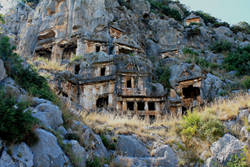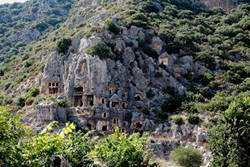Rock-cut Tombs in Myra
Useful Information
| Location: | Kale or Demre, Antalya Province. (36.259167, 29.985278) |
| Open: | |
| Fee: | |
| Classification: |
 Cave Tomb Cave Tomb
|
| Light: | n/a |
| Dimension: | |
| Guided tours: | |
| Photography: | allowed |
| Accessibility: | no |
| Bibliography: | |
| Address: | Myra Antik Kenti Myra Örenyeri 07570 Demre/Antalya Umfangreiches archäologisches Museum von 1922 mit Ausstellungsgalerien, Café und Geschenkladen. +90 242 871 68 21 |
| As far as we know this information was accurate when it was published (see years in brackets), but may have changed since then. Please check rates and details directly with the companies in question if you need more recent info. |
|
History
| 1840 | visited by the traveller Charles Fellows. |
Description


Myra was listed as a member of the Lykiakon systema (Lycian league) (168 BC – 43). According to Strabo (14:665) it was one of the largest towns of the alliance. Pliny the Elder writes about the spring of Apollo called Curium- When summoned three times by the pipe the fishes come to give oracular responses. During the Roman period Myra formed a part of the Koine Greek speaking world that rapidly embraced Christianity. The ruins of the Lycian and Roman town Myra are mostly are today covered by alluvial silts. The Acropolis on the Demre-plateau, the Roman theatre and the Roman baths (eski hamam) have been partly excavated.
There are two necropoleis at Myra. The ocean necropol is located at the northwest side of the Roman theatre. The river necropolis is located 1.5 km up the Demre Cayi from the theater Here is the Lion’s tomb, also called the Painted Tomb, which is the most famous tomb in Myra.
Lycian rock-cut tombs are quite distinct, temple fronts carved into the vertical faces of cliffs. When the traveller Charles Fellows saw the tombs in 1840 he found them still colorfully painted red, yellow and blue. Today all the color has gone.
 Search DuckDuckGo for "Rock-cut Tombs in Myra"
Search DuckDuckGo for "Rock-cut Tombs in Myra" Google Earth Placemark
Google Earth Placemark Myra - Wikipedia (visited: 27-JUN-2020)
Myra - Wikipedia (visited: 27-JUN-2020) Index
Index Topics
Topics Hierarchical
Hierarchical Countries
Countries Maps
Maps